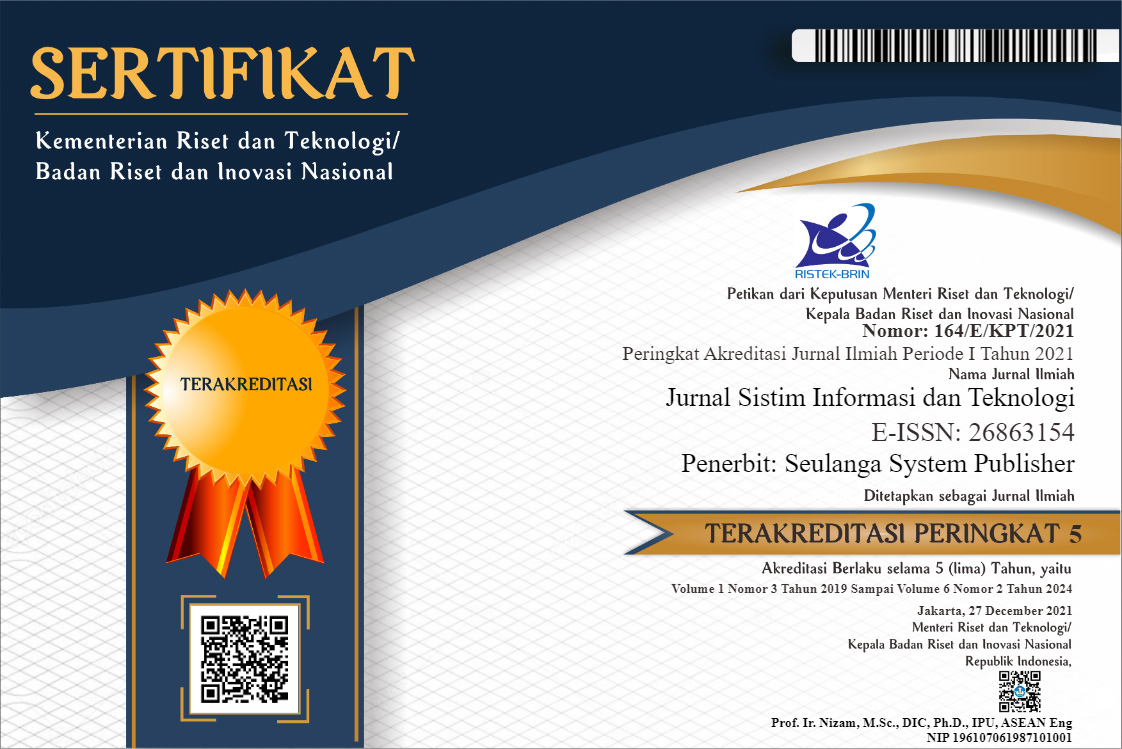Prediksi Pencapaian Target Peserta Keluarga Berencana Pasca Persalinan menggunakan Algoritma Backpropagation
DOI:
https://doi.org/10.37034/jsisfotek.v3i3.62Keywords:
Prediction, Family Planning, Postpartum, DPPKBP3A, BackpropagationAbstract
Population growth in Indonesia continues to increase, so the government makes a program to control the rate of growth of the population, namely the Family Planning Program (KB). The implementation of family planning also has another objective, namely to reduce the risk of maternal death after childbirth. To measure the level of increasing target achievement of postpartum family planning participants. So that it can be a reference for the DPPKBP3A in carrying out the postpartum family planning program. Data from the Population Control, Family Planning, Women Empowerment and Child Protection (DPPKBP3A) District Lima Puluh Kota data processed in this study is data on the achievement of postpartum family planning participants from 2018 to 2020. Data processing uses the Backpropagation algorithm through several stages, namely the stage initialization, activation stage, weight training (weight change) and iteration stage. One of the results obtained from the calculation is the comparison of the target with the output gradient error in Suliki District in 2018, namely the target of 0.11311 and the result of the error gradient output is -0.1171. The prediction results obtained from this process become a reference for the Population Control, Family Planning and Women Empowerment and Child Protection Agency (DPPKBP3A) of District Lima Puluh Kota to implement the implementation of postpartum family planning programs to the community the following year.
References
Trianziani, S. (2018). Pelaksanaan Program Keluarga Berencana oleh Petugas Lapangan Keluarga Berencana (PLKB) di Desa Karangjaladri Kecamatan Parigi Kabupaten Pangandaran. Jurnal MODERAT, Volume 4, Nomor 4,November 2018, hlm 131-149 .DOI: http://dx.doi.org/10.25147/moderat.v4i4.1812.
Sitorus, F.M., & Siahaan, J. M. (2018). Pelayanan Keluarga Berencana Pasca Persalinan dalam Upaya Mendukung Percepatan Penurunan Angka Kematian Ibu. Midwifery Journal. DOI: https://doi.org/10.31764/mj.v3i2.505.
Nurdela ,S. A. (2017). Aplikasi Peramalan Jumlah Kelahiran dengan Metode Jaringan Syaraf Tiruan. The Indonesian Journal of Public Health, Vol. 12 No. 2, 213–223. DOI: 10.20473/ijph.v12i1.2017.213-223.
Mustopa, A., Wildah, S. K., Wijaya,G., Gata, W., & Agustiani, S. (2020). Pengaruh Media Terhadap Pengambilan Keputusan Dalam Menjalankan Program Keluarga Berencana Dengan Algoritma Decision Tree. Paradigma – Jurnal Informatika dan Komputer, Vol. 22, No. 2.DOI: https://doi.org/10.31294/p.v22i2.8141.
Adjie, J.M.S., Maya, G.,Manurung, C.,Hermawan, L. C., Elmida, M., Sofyan, M., Sujoko, A., Hafrida, I.,Aifiani, N. R.,Citarasmi, I. A.,Nugroho, P.,Masnawati., Melanie, H.,Amalia, D. O.,Merthawati, I. A. P., Milwiyandia., Rusmiyati.,Wiwit., Ekawati, D.,Husaini., Tiara, A. D., Mudjiati, I., Hutagalung, S., Kulsum, S.,Pakpahan, C. (2014). Pedoman Pelayanan Keluarga Berencana Pasca Persalinan di Fasilitas Kesehatan. Jakarta. Katalog Kementerian Kesehatan RI. 36-53.
Alkronz, E.S., Moghayer, K. A.,Meimeh, M., Gazzaz, M., Nasser, B. S. A., & Naser, S. S. A. (2019). Prediction of Whether Mushroom is Edible or Poisonous Using Back-propagation Neural Network. International Journal of Academic and Applied Research (IJAAR) Vol. 3 Issue 2, Pages:1-8.DOI: http://dstore.alazhar.edu.ps/xmlui/handle/123456789/126.
Zola, Fatmi.,Nurcahyo, G. W.,& Santony, J. (2018). Jaringan Syaraf Tiruan Menggunakan Algoritma Backpropagation untuk Memprediksi Prestasi Siswa. Jurnal Teknologidan Open Source Vol. 1 No. 1.DOI: https://doi.org/10.36378/jtos.v1i1.12.
Syukri, & Samsuddin. (2018). Pengujian Algoritma Artificial Neural Network (ANN) untuk Prediksi Kecepatan Angin. Jurnal Nasional Komputasi dan Teknologi Informasi Vol.2 No.1.DOI: https://doi.org/10.32672/jnkti.v2i1.1056.
Aini, H., Haviluddin., Budiman, E., Wati, M., & Puspitasari, N. (2019). Prediksi Produksi Minyak Kelapa Sawit Menggunakan Metode Backpropagation Neural Network. Sains, Aplikasi, Komputasi dan Teknologi Informasi, Vol 1, No 1, pp. 24-33.DOI: http://dx.doi.org/10.30872/jsakti.v1i1.2261.
Setti, S., Sihotang, B. K., Wanto, A., Syafiq, M., &Andriano, A. (2018). Analysis of Backpropagation Algorithms in Predicting WorldInternet Users.IOP Conf. Series: Journal of Physics: Conf. Series 1255. DOI:10.1088/1742-6596/1255/1/012018.
Geng. R., Wang, X., Ye, N., & Liu, J. (2018). A Fault Prediction Algorithm Based on Rough Sets and Back Propagation Neural Network for Vehicular Networks. IEEE, VOLUME 6. DOI: 10.1109/ACCESS.2018.2881890.
Qin, Y., & Zheng, C. (2019). A Backpropagation Neural Network-based Flexural-tensile Strength Prediction Model for Asphalt Mixture in Cold Regions under Cyclic Thermal Stress. IIETA, Vol. 6, No. 3, pp. 433-436. DOI: https://doi.org/10.18280/mmep.060315.
Lin, J. W., Chao, C. T., &Chiou, J. S. (2018).Determining Neuronal Number in Each Hidden Layer Using Earthquake Catalogues as Training Data in Training an Embedded Back Propagation Neural Network for Predicting Earthquake Magnitude. IEEE, VOLUME 6. DOI: 10.1109/ACCESS.2018.2870189.
Lubis, M. R. (2018). Analisis Jaringan Saraf Tiruan Backpropgation untuk Peningkatan Akurasi Prediksi Hasil Pertandingan Sepakbola. TECHSI: Vol. 10, No. 1. DOI: https://doi.org/10.29103/techsi.v10i1.560.
Andriani, Y., Silitonga, H., &Wanto, A. (2018). Analisis Jaringan Syaraf Tiruan untuk Prediksi Volume Ekspor dan Impor Migas di Indonesia. Jurnal Ilmiah Teknologi Sistem Informasi 4 (1) 2018 30-40. DOI :https://doi.org/10.26594/register.v4i1.1157.
Yanto, M., Mulyani. S. R., & Mayola, L. (2019). Peramalan Jumlah Produksi Air dengan Algoritma Backpropagation .Sebatik, 23(1), pp. 172-177. DOI: https://doi.org/10.46984/sebatik.v23i1.465.
Sijabat, P. I., Yuhandri, Nurcahyo, G. W., Sindar, A. (2020). Algoritma Backpropagation Prediksi Harga Komoditi terhadap Karakteristik Konsumen Produk Kopi Lokal Nasional. Jurnal Teknologi Informasi & Komunikasi Digital Zone, Volume 11, Nomor 1: 96-107. DOI: https://doi.org/10.31849/digitalzone.v11i1.3880ICC









